AMD Radeon R9 Fury X 4GB Review
Can AMD's complex Fiji GPU, groundbreaking memory tech and closed-loop cooler generate enough performance to usurp Nvidia’s GeForce GTX 980 Ti?
Power Consumption
Introducing the New and Improved PowerTune
As you looked at all of those performance numbers, did you find yourself wondering if AMD could significantly reduce Radeon R9 Fury X's power consumption? We slightly modified our measurement setup in anticipation. This allows us to analyze how well AMD’s updated PowerTune technology is able to adjust the card’s draw in response to load, temperature and other variables. We're looking for fast response in short intervals. And in order to test accurately, our equipment is set for 100-microsecond sampling in order to record every last fluctuation.
It turns out that PowerTune takes big strides toward improved resolution and gradation! In spite of us running up against the limits of our logging technology, yielding curves that don’t look as nice anymore in spite of high-cut filtering, the bottom line is undeniable: PowerTune is now able to react to parameter changes in intervals of 10 microseconds or less. The following chart shows what happens over a time period of just 100 microseconds.
AMD’s engineers deserve some praise; these results look like they come from a card based on Nvidia's Maxwell architecture. Now we want to know how our observations are reflected in the individual load scenarios. Theoretically speaking, the power consumption at idle should be markedly lower, whereas the stress test might, unfortunately, trigger a massive increase. That is unless AMD set a conservative limit just like Nvidia did, since nothing can be predicted, and thus saved, under continuous full load. We’ll answer all of these questions in detail below.
The peaks in these tables don’t always occur at the same time, since the total peak power consumption isn’t always the sum of the peaks on the individual rails. Maximums can happen at different times.
Idle Power Consumption
AMD’s Radeon R9 Fury X meets our lofty expectations. On the one hand, HBM consumes a lot less power than GDDR5. On the other, there's a pump and a larger fan that need to be taken into consideration. Their combined consumption shouldn’t be much lower than 2W, though. In light of this, the 4.8W we measure is a fantastic result. And it holds up even when we connect more than one monitor. AMD has finally taken care of this anachronism, which was long overdue. The end result comes in well under Nvidia's reference GeForce GTX 980 Ti as well.
| Header Cell - Column 0 | Minimum | Maximum | Average |
|---|---|---|---|
| PCIe Total | 0.00W | 15.60W | 2.88W |
| Motherboard 3.3V | 0.00W | 0.99W | 0.26W |
| Motherboard12V | 0.00W | 7.80W | 1.65W |
| Graphics Card Total | 0.00W | 21.96W | 4.80W |
We also see that the auxiliary 3.3V rail isn't really a factor anymore. The other rails fluctuate between zero and a peak here and there. The average looks great though, and this is reflected in each rail's measurement curve.


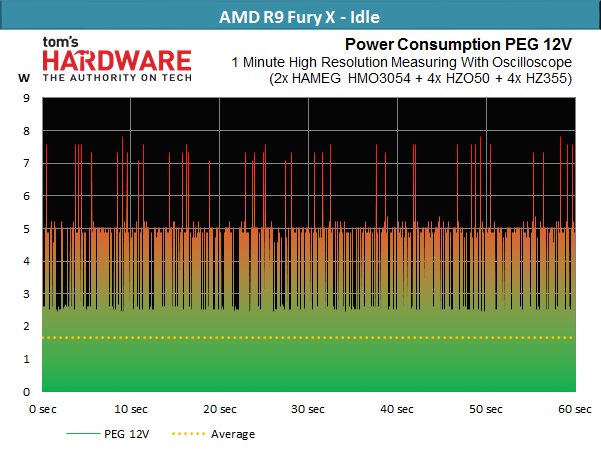

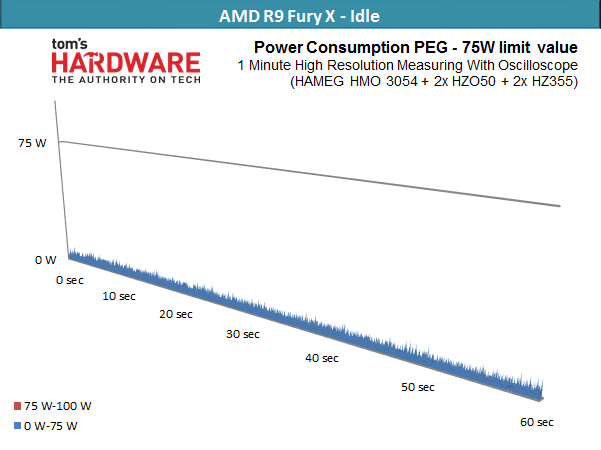


Overview of all tested graphics cards
Get Tom's Hardware's best news and in-depth reviews, straight to your inbox.
Gaming Power Consumption
This is the result that most of you will be interested in after checking out the gaming benchmarks. And again, the news looks good. An average just under 221W for AMD’s Radeon R9 Fury X after a warm-up period (it registers 216W cold) is well under what we observed from Nvidia's reference GeForce GTX 980 Ti! The 12W difference might not be a lot, but it's enough to send a clear message.
A Fiji GPU with some of its resources disabled or dialed to a lower clock rate would likely be more efficient, too. That makes the hotly anticipated Radeon R9 Fury Nano a much more plausible concept.
| Header Cell - Column 0 | Minimum | Maximum | Average |
|---|---|---|---|
| PCIe Total | 25.20W | 428.80W | 209.81W |
| Motherboard 3.3V | 0.00W | 1.32W | 0.33W |
| Motherboard 12V | 0.00W | 31.20W | 10.55W |
| Graphics Card Total | 25.53W | 453.58W | 220.69W |
Once again, the 3.3V rail isn't really used. It's joined by the motherboard's 12V rail, which apparently isn't needed either. This is particularly notable, since it means that almost all of the heavy lifting is done by the auxiliary PCIe power connectors. As a pleasant side effect, potential high-frequency load fluctuations of more than 100KHz don’t travel through the supply line, where they can reach and modulate the audio components.
The individual rails are interesting to look at, since the load fluctuations can be identified quite easily:



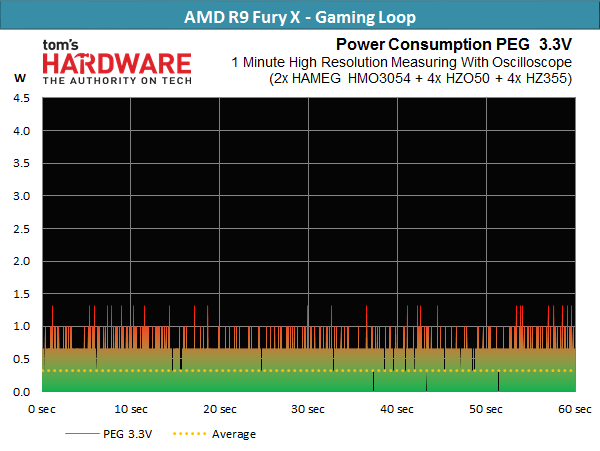

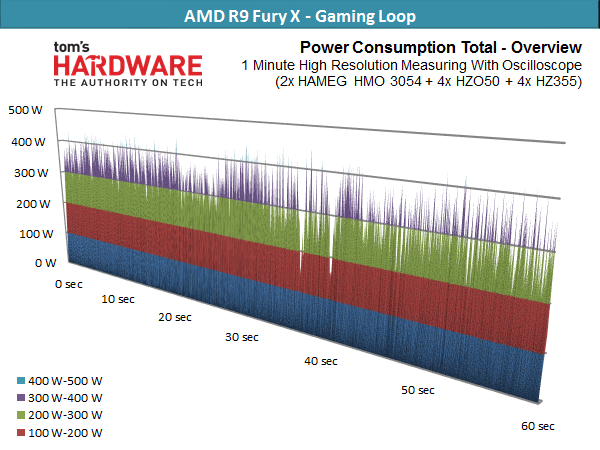

Overview of all tested graphics cards
Stress Test Power Consumption
If AMD hadn't imposed a strict limit, power consumption might have veered out of control under full load. And sure enough, the Radeon R9 Fury X can get warm and cozy just under 348W. Granted, this only happens under what the company would consider a power virus, or some OpenCL-based task capable of hammering Fiji's shaders. Compute-heavy workloads also tend to run for longer than typical synthetic benchmarks.
Given the liquid cooler, AMD grants its Radeon R9 Fury X a much more generous power ceiling than Nvidia permits for GeForce GTX 980 Ti. If that extra ~100W of draw can be considered good or bad is up for debate. Regardless, it's unlikely that you'll ever see this limit under normal use.
| Header Cell - Column 0 | Minimum | Maximum | Average |
|---|---|---|---|
| PCIe Total | 30.24W | 421.20W | 327.80W |
| Motherboard 3.3V | 0.00W | 1.65W | 0.68W |
| Motherboard 12V | 2.60W | 31.20W | 19.02W |
| Graphics Card Total | 40.32W | 448.52W | 347.49W |
Here are the separate curves for the individual rails one last time:



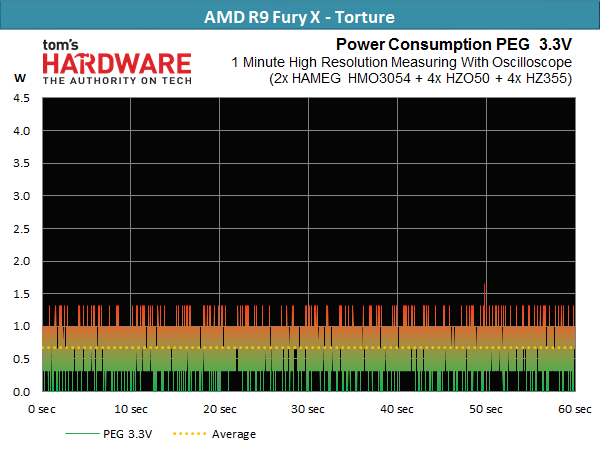


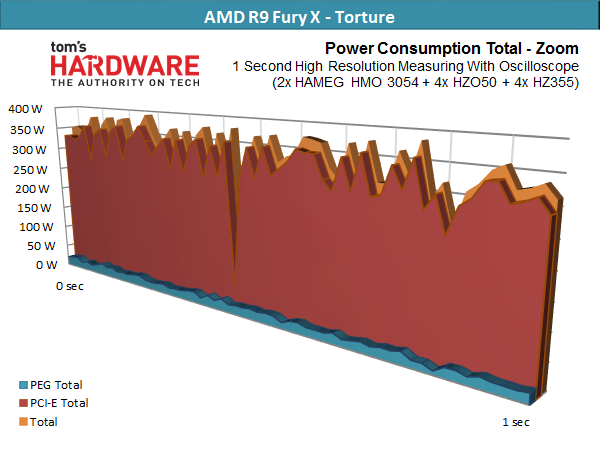
Overview of all tested graphics cards
AMD does a great job managing power, and we're happy to see the company competing on a more even footing with Nvidia in this area as well. The Radeon R9 Fury X even manages to beat Nvidia’s reference GeForce GTX 980 Ti due to the Fury's better cooling and the resulting lower leakage currents.
Current page: Power Consumption
Prev Page Thief And Tomb Raider Next Page Temperatures, Clock Rates And Noise-
endy0307 very nice just what i wanted since i dont to nvidia for personal reasons, now i never buy into hype either i tend to wait it out fofr revisions but this one is going to be my 2 year card,.since i only game at 2k and d dalarererady havefrereesyync monitotoReply -
wh3resmycar same here, disappointment... guru3d has calculated tdp around 300w for this card. not good at all.. 4096-bit and this is it? once nvidia goes HBM i don't know how AMD will be able to compete with it.Reply -
Free2play_noobs What's the driver version You have used for this review ? Has AMD released any separate driver for Fury X?Reply

